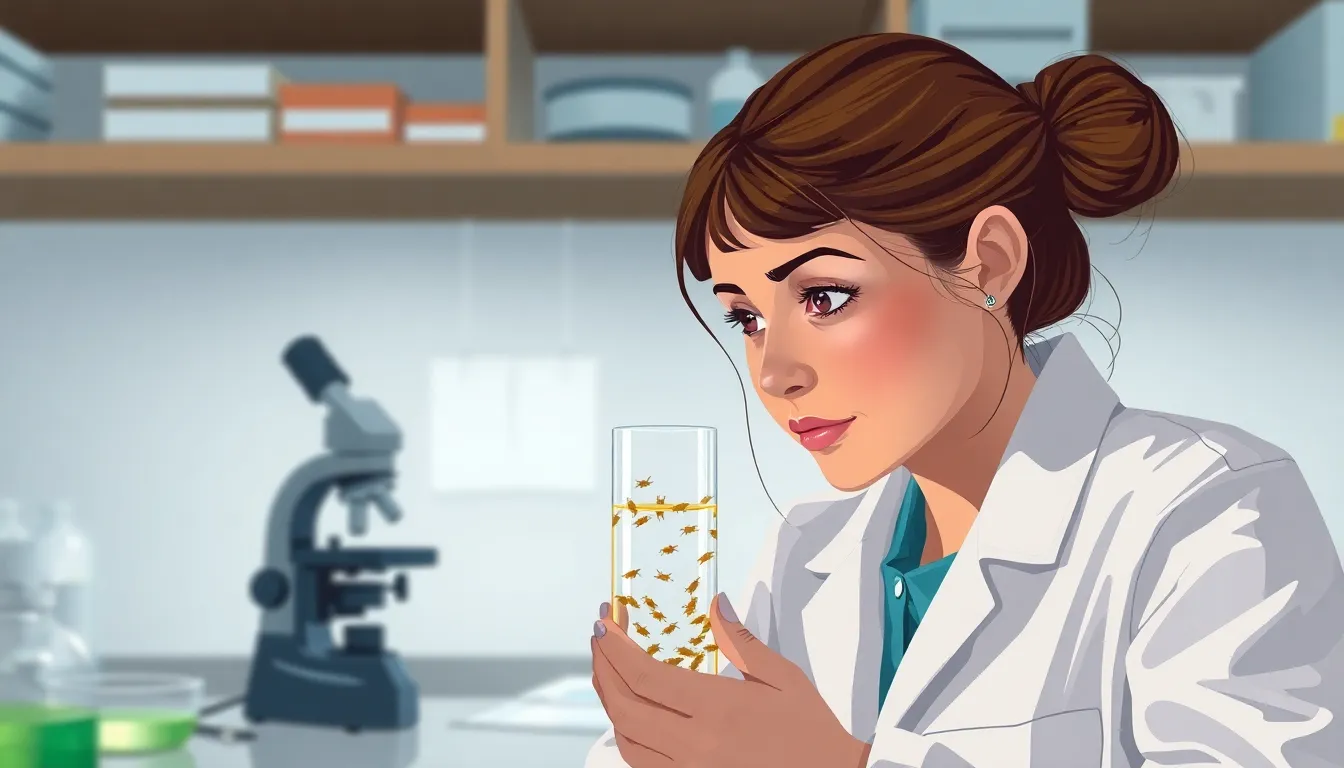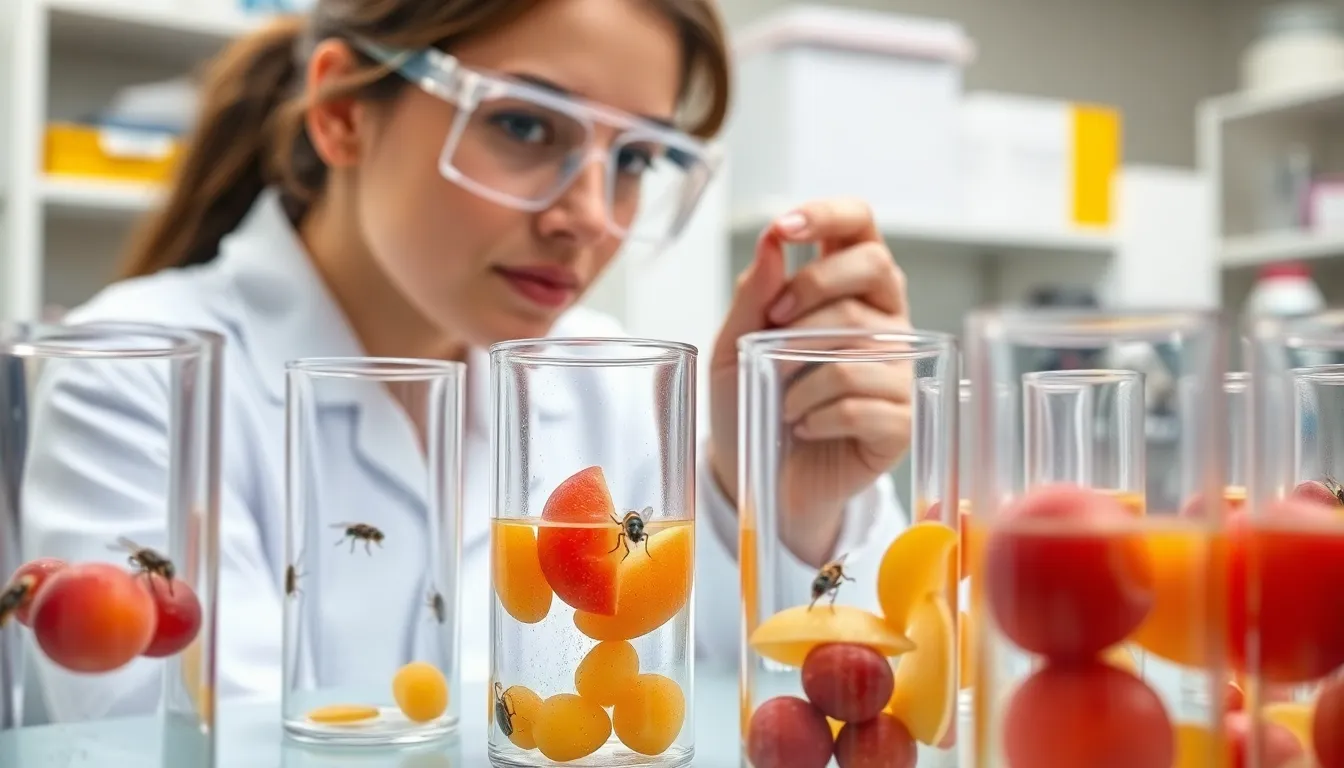Fruit flies might not be the most glamorous creatures in the insect kingdom, but they sure know how to throw a party. With their rapid reproduction and insatiable appetite for ripe fruit, these tiny pests have become the life of the laboratory. Scientists and hobbyists alike have embraced fruit fly culture, transforming these little buzzers into the ultimate research companions.
Table of Contents
ToggleOverview of Fruit Fly Culture
Fruit fly culture involves the systematic breeding and maintenance of Drosophila melanogaster, a species commonly used in genetics and developmental biology. This organism thrives in environments with abundant fermenting fruit, making it easy to cultivate in laboratory settings. Researchers can establish fruit fly populations in small containers that contain a nutrient-rich medium, often incorporating cornmeal, sugar, and yeast.
Cultivating fruit flies offers numerous advantages. Rapid reproductive cycles enable researchers to observe many generations within short timeframes, allowing for efficient study of genetic variations and phenotypic expressions. Each breeding cycle typically lasts about two weeks, from egg to adult, facilitating extensive experimental timelines.
Maintaining fruit fly cultures requires attention to specific environmental factors. Temperature control is vital for optimal growth; keeping temperatures around 25°C promotes healthy development. Additionally, proper ventilation and humidity levels must be monitored to prevent mold growth and ensure fly vitality.
Fruit flies display remarkable genetic diversity, with over 15,000 genes identified in their genome. This diversity supports various genetic experiments, including studies on heredity, mutation effects, and disease models. By manipulating their genetic makeup, scientists can explore fundamental biological mechanisms relevant to human health.
Culturing fruit flies also invites collaboration among scientists and hobbyists alike. Many individuals find joy in breeding their own fruit fly populations for educational purposes or simple enjoyment. Resources and guidelines for successful fruit fly culture are widely available, enhancing accessibility for anyone interested in exploring the fascinating world of this tiny insect.
Importance of Fruit Fly Culture

Fruit fly culture plays a crucial role in scientific exploration. This tiny insect offers a wealth of opportunities for research and education.
Research Applications
Drosophila melanogaster serves as an invaluable model organism in research settings. It allows scientists to examine complex genetic processes and developmental biology concepts. Researchers exploit its rapid life cycle, facilitating the observation of several generations in short periods. Genetic variations observed in fruit flies contribute to a greater understanding of human genetic diseases. By studying the fruit fly’s 15,000 identified genes, researchers can draw parallels to human health. This organism’s simple genome and interactive breeding practices make it easier for labs to conduct experiments. Studies involving behavior, physiology, and evolutionary biology benefit from the insights gained through fruit fly research.
Educational Uses
Fruit fly culture finds significant applications in educational environments. Students engage in hands-on experiments, deepening their understanding of genetics and biological principles. Lab exercises using fruit flies foster critical thinking as students analyze outcomes of genetic crosses. This immersion into genetic principles can ignite interest in fields such as biology and genetics. Classrooms often use fruit fly cultures for illustrating Mendelian inheritance and environmental impacts on phenotype. Additionally, access to resources encourages teachers to implement fruit fly projects. Such initiatives empower students to participate in scientific inquiry while equipping them with essential research skills.
Setting Up a Fruit Fly Culture
Setting up a fruit fly culture requires careful planning and execution. This process ensures a thriving environment for Drosophila melanogaster.
Necessary Materials
Essential materials include small containers, nutrient-rich media, and fresh fruit. Small containers, such as vials or jars, provide adequate space for breeding. Nutrient-rich media, like yeast and cornmeal mixtures, supplies necessary sustenance. Fresh fruit, particularly ripe bananas or apples, attracts fruit flies and contributes to their growth. Additional supplies consist of cotton plugs to cover containers, labels to identify cultures, and a fine mesh for ventilation.
Step-by-Step Instructions
Start by preparing the nutrient-rich medium. Mix active yeast with cornmeal and water in a clean container. Next, pour the mixture into vials, filling each about one-third full. After that, introduce pieces of ripe fruit into each vial to serve as a food source. Cover each container with cotton plugs to allow airflow while preventing escapes. Position the containers in a stable environment, maintaining temperatures between 20°C to 25°C. Observe the cultures routinely, checking for signs of activity and growth. Regularly transfer cultures to new containers to maintain health and vitality.
Maintaining Your Fruit Fly Culture
Maintaining a healthy fruit fly culture involves creating optimal living conditions and addressing common challenges effectively.
Optimal Conditions
Temperature plays a key role in fruit fly development. Ideally, temperatures should range between 20°C and 25°C. Proper ventilation prevents stagnation in the culture, allowing for air circulation. Humidity also impacts growth; a relative humidity level of around 60% benefits fruit flies. Light exposure, while not crucial, can influence activity, making a 12-hour light and 12-hour dark cycle effective. Furthermore, the nutrient medium must stay fresh to avoid mold growth; regular replenishment keeps the culture thriving.
Common Challenges
Maintaining fruit fly cultures involves overcoming specific challenges. Mold can develop in nutrient mediums, requiring regular checks and prompt removal of contaminated cultures. Overcrowding may lead to competition and stunted growth; transferring flies to new cultures helps mitigate this issue. Disease outbreaks can also threaten the population, highlighting the need for proper hygiene practices and equipment sterilization. Additionally, genetic drift could occur after several generations, leading to surprising results in experiments; careful selection of breeding pairs counters this effect. Addressing these challenges proactively ensures a successful fruit fly culture.
Troubleshooting Common Issues
Mold growth in fruit fly cultures often disrupts healthy populations. To counter mold, keep cultures dry and check them regularly for excess moisture. Overcrowding can lead to stress and reduced viability. Ensure adequate space in containers to prevent overpopulation, transferring flies as necessary.
Disease outbreaks present significant threats to cultures and can occur unexpectedly. Implementing good hygiene practices minimizes risks. Clean containers regularly and avoid cross-contamination by using separate tools for different cultures.
Genetic drift affects offspring uniformity and can create unintended variations. Regularly introducing fresh genetic stock from different sources helps maintain diversity and stability in cultures. Monitoring behaviors and traits provides insight into genetic variations.
Temperature fluctuations can adversely affect development and reproduction rates. Maintaining a stable environment, ideally between 20°C and 25°C, prevents these fluctuations. Humidity plays a crucial role too, with levels around 60% being ideal for optimal growth.
Fluctuating light conditions can influence fruit fly activity levels. Implementing a consistent light and dark cycle supports healthy behavior. A 12-hour cycle often proves beneficial, assisting in maintaining reproduction rates.
Pay attention to nutrient levels in media, as insufficient nutrition strains fruit fly populations. Using fresh, nutrient-rich mediums such as cornmeal and yeast fosters a thriving environment. Regularly replacing old media with new food ensures ample sustenance for the flies.
By proactively identifying and addressing these common issues, both researchers and hobbyists can nurture healthy fruit fly cultures, maximizing the benefits of their work.
Fruit fly culture represents a vital intersection of research and education. By engaging with Drosophila melanogaster, researchers and students alike gain invaluable insights into genetics and developmental biology. The ease of cultivation and rapid life cycles make these organisms ideal for exploring complex genetic concepts.
As more individuals delve into this fascinating area, the collaborative spirit of fruit fly culture continues to thrive. With the right resources and attention to detail, anyone can successfully maintain a culture that contributes to scientific discovery. This not only enhances understanding but also inspires future generations of biologists and researchers. The journey into fruit fly culture is both rewarding and enlightening, paving the way for innovative research and educational opportunities.



